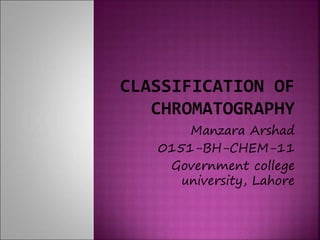This document provides an overview of chromatography. It discusses the history and discovery of chromatography by Tswett in 1906. It then defines chromatography and describes the basic components of a chromatogram. The document classifies chromatography by mobile and stationary phase as well as by separation mechanism. It discusses various chromatography techniques including thin layer chromatography, column chromatography, gas chromatography, and high performance liquid chromatography. It also covers separation factors such as solute retention, capacity factor, and efficiency.






















































